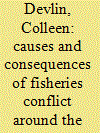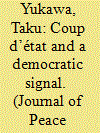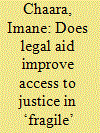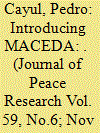|
|
|
Sort Order |
|
|
|
Items / Page
|
|
|
|
|
|
|
| Srl | Item |
| 1 |
ID:
189003


|
|
|
|
|
| Summary/Abstract |
Fisheries conflict is an underappreciated threat to the stability and health of communities. Declining fish populations, rising demand for seafood, and efforts to reduce illegal fishing are increasing the risk that conflict over fisheries resources will undermine stability and peace. Here, we investigate the frequency, causes, and consequences of fisheries conflict in six countries around the Horn of Africa and East Africa (Tanzania, Kenya, Somalia, Djibouti, Eritrea, and Yemen) between 1990 and 2017. Fisheries conflict events were cataloged from news reports, and events were characterized by the date, location, actors, consequences, and drivers of the conflict. We found the rate of fisheries conflict is gradually increasing in the region, with spikes in conflict driven by the arrival of foreign fishing boats or international naval vessels. Conflict was caused primarily by illegal fishing, foreign fishing, weak governance, limits on access to fishing grounds, and criminal activities including piracy. Two-thirds of all conflict events occurred in Kenyan and Somali waters, with areas of high conflict intensity in the Lake Victoria region, near the Somali coastline, and in the southern Red Sea. During this period, 684 fisheries conflict events in the region resulted in over 400 fatalities, nearly 500 injuries, and over 4,000 arrests.
|
|
|
|
|
|
|
|
|
|
|
|
|
|
|
|
| 2 |
ID:
188999


|
|
|
|
|
| Summary/Abstract |
What connection exists between protests and coup attempts? Although recent studies have revealed that the former incites the latter, they generally do not consider international factors. We contend that post-Cold War nonviolent protests have promoted coup attempts. With sentiment in the international community turning against coups following the end of the Cold War, coup organizers have had to portray their actions as democratic. Launching a coup attempt during ongoing nonviolent protests became a convincing method to prove democratic bona fides. This is because the international community favors nonviolence, and it signals that the emerging regime will not have extreme preferences and will keep order. Conversely, the international community does not regard violent protests as legitimate, and staging a coup attempt during violent protests will not enable a military to claim legitimacy. This argument is tested through statistical analysis and by using the 2011 Egyptian coup as a case study. As expected, the results indicate that the impact of protests on coup attempts varies depending on (1) whether those protests are violent or nonviolent, and on (2) the period. Specifically, only the nonviolent protests in the post-Cold War era prompt coup attempts meaningfully.
|
|
|
|
|
|
|
|
|
|
|
|
|
|
|
|
| 3 |
ID:
188998


|
|
|
|
|
| Summary/Abstract |
Access to justice is often described as key for building and consolidating peace and enhancing socio-economic development in fragile and post-conflict states. Since the 2000s, legal empowerment has been one of the most popular approaches to improve such access, and a growing literature has presented mixed evidence on the quality of its outcomes. We evaluate and discuss the impact of a locally provisioned legal aid program on justice-seekers’ use of dispute resolution fora, legal agency, and trust in judicial institutions. The program was implemented between 2011 and 2014 in 26 municipalities of rural Burundi. We consider its effects on 486 beneficiaries using various propensity score-matching methods and data on non-beneficiaries from two distinct control groups (n = 3,267). Forty-eight interviews with key informants help discuss judicial practices. We find that the program increased the use of courts but not trust in the judiciary. It had no significant impact on the use of alternative dispute resolution mechanisms. Qualitative and quantitative evidence suggests that justice-seekers’ perception of the treatment they received in courts, also known as procedural justice, shaped their perception of accessing justice. Qualitative evidence also points to a possible ‘watchdog effect’: in some cases, the presence of a legal adviser may have pushed judges to better comply with procedures. While legal aid programs can improve access to courts, it does not necessarily mean an erosion of judicial ‘forum shopping’ or that trust in state institutions is reinforced and rights fully realized.
|
|
|
|
|
|
|
|
|
|
|
|
|
|
|
|
| 4 |
ID:
188997


|
|
|
|
|
| Summary/Abstract |
When and why do citizens living amid criminal violence pour into the streets to demand peace and justice, regardless of the risks that protesting in such a context may entail? While victimization experiences provide an initial motivation for participation in protests, this article finds that social networks play a fundamental role for mobilization against insecurity. At an emotional level, socialization within networks helps transform the feelings of individual fear that crime evokes into collective anger that represents potential for action. As individuals become more engaged with one another, their feelings are transformed from being exclusively self-oriented towards other-oriented. Additionally, denser network interactions insulate participants from coercion and generate support mechanisms for their members, creating a sense of security. Thus, networks have the power to transform perceptions of the risks and effectiveness associated with their collective action against crime. Supporting evidence for this argument is derived from original survey data collected in Mexico in 2012. Additionally, in-depth interviews with protest participants reveal the mechanisms through which social networks stimulate protest participation, among both victims and non-victims. This article contributes to the prevailing literature on victimization and political participation and provides new answers on when and how experience with violence can encourage involvement in politics and promote democratic accountability.
|
|
|
|
|
|
|
|
|
|
|
|
|
|
|
|
| 5 |
ID:
189004


|
|
|
|
|
| Summary/Abstract |
This article introduces MACEDA, a micro-level dataset on the self-determination (SD) conflict between the Chilean state and the indigenous Mapuche. Although SD disputes are one of the most common conflicts in the world, and indigenous movements represent about 40% of all SD movements, this is the first micro-dataset focused on an indigenous SD conflict. MACEDA covers the period 1990–2016, including more than 2,600 events collected from local media. As indigenous conflicts are much less violent in terms of casualties, we take a flexible definition of conflict, based on its constituent events, and we discuss the comparability and generalization of our approach. To illustrate the usefulness of these micro-data in the analysis of conflict-related theories, we present a descriptive empirical analysis on the strategies of indigenous resistance, and we discuss how the data can be used in the causal analysis of conflicts.
|
|
|
|
|
|
|
|
|
|
|
|
|
|
|
|
| 6 |
ID:
189001


|
|
|
|
|
| Summary/Abstract |
Does state weakness increase support for ethnic violence? This study proposes individuals who feel insecure due to state weakness are more likely to support interethnic violence conditional on exposure to chauvinist messaging. Support for interethnic violence is evaluated through a survey experiment in Southern Kyrgyzstan. The results show random assignment of chauvinist nationalist rhetoric only induces support for interethnic violence among respondents who trust informal non-state actors from their ethnic group to provide them security. The findings suggest state weakness leads individuals to view their ethnic group as an alternative provider of security and that when primed by chauvinist rhetoric, these individuals become more supportive of violence on their group’s behalf. A case study of the 2010 riots in the Southern Kyrgyz city of Osh illustrates how underlying support for violence may escalate to actual violence as a result of state breakdown, examining events in the months after the Kyrgyz state lost authority following the April 2010 revolution. Jointly, the survey findings and case study illustrate pathways for violence in ethnically divided low-capacity environments and potential drawbacks from protest-oriented revolutions.
|
|
|
|
|
|
|
|
|
|
|
|
|
|
|
|
| 7 |
ID:
189000


|
|
|
|
|
| Summary/Abstract |
How does exposure to aerial bombing influence voting for the target country’s leadership? Do voters tend to punish incumbents for policy failure? These questions are relevant for understanding the target country’s postwar politics because aerial bombing remains one of the deadliest and most widely used military options for coercive bargaining. Despite the historical and contemporary relevance of these questions, there are only a few studies in the air-power literature arguing that strategic bombing produces a temporary rally effect but no subsequent political consequences other than political apathy. Most studies ignore important variation within states even though leadership responsibility can vary tremendously on the substate level. This article analyzes the effect of the 1999 NATO bombing of Yugoslavia on Serbian local elections using the difference-in-differences identification strategy and identifies the effect of airstrikes on the vote-share of Slobodan Milosevic’s regime. The results show that the regime’s vote-share is 2.6% lower in municipalities exposed to the bombing. Challenging prior studies, this finding demonstrates that retrospective voting applies to aerial bombing even in competitive authoritarian regimes.
|
|
|
|
|
|
|
|
|
|
|
|
|
|
|
|
| 8 |
ID:
188996


|
|
|
|
|
| Summary/Abstract |
Scholars have found that nonviolent resistance is more effective than violence at promoting post-campaign democratization. We explore whether this relationship extends to judicial systems, specifically. Courts have been shown to be important for promoting and protecting economic development and political rights, yet they have been largely ignored in quantitative studies of post-conflict democratization. We posit that leaders who hold power after domestic unrest will be more inclined to use independent courts as a mechanism to prevent future campaigns–but they do so primarily when fearing a significant mobilization threat and when expecting legal action to be an acceptable channel for dispute resolution by dissidents. As such, we anticipate that levels of judicial independence are higher following nonviolent campaigns as compared to violent conflicts. Using quantitative data from violent and nonviolent campaigns globally, we find that judicial independence is indeed higher in the aftermath of nonviolent, as compared to violent, resistance campaigns. Furthermore, a campaign’s outcome does not matter; post-conflict judicial independence appears to be associated with tactics, not dissident success.
|
|
|
|
|
|
|
|
|
|
|
|
|
|
|
|
| 9 |
ID:
189002


|
|
|
|
|
| Summary/Abstract |
In this article, we introduce an updated version of the Nonviolent and Violent Campaigns and Outcomes dataset (NAVCO 2.1), which compiles annual data on 389 nonviolent and violent mass movements for regime change, anti-occupation, and secession from 1945 to 2013. This version of the dataset corrects known coding errors in NAVCO 2.0, adds news cases (including the Arab uprisings), and codes attributes for each campaign year (such as participation size and diversity, the behavior of regime elites, repression and its effects, support from external actors, and campaign outcomes). In addition, NAVCO 2.1 adds several new attributes to each campaign-year, including more precise participation figures, more nuanced data about the scope, intensity, and degree of violent flank behavior and state repression, and further information about the parallel or alternative institutions developed by the campaign. The data reveal four key findings: (1) that the success rate of nonviolent resistance campaigns has declined since 2001; (2) that far more people have participated in nonviolent than violent campaigns in the postwar period; (3) that nonviolent campaigns suffer far fewer per-capita fatalities than armed campaigns; and (4) that incidental violence by dissidents has become a more common feature of contemporary nonviolent campaigns compared with earlier cases. The article concludes with suggestions for further research.
|
|
|
|
|
|
|
|
|
|
|
|
|
|
|
|
|
|
|
|
|